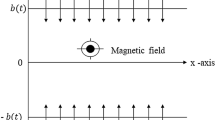Abstract
The aim of this study is to investigate the laminar fluid hammer phenomenon in viscoelastic fluids through a straight pipe. To pursue this aim, the finite-volume method is adopted to numerically assess the influences of the viscoelastic non-dimensional parameters on the viscoelastic fluid hammer in an axisymmetric pipe. Herein, the Phan–Thien–Tanner model is selected as the constitutive equation, which could be used to study the viscosity ratio, Deborah number, and the extensibility parameter simultaneously. The results are in good agreement with the experimental data and analytical solution. The impacts of the viscosity ratio, the Deborah number, and the extensibility parameter in constant Reynolds number on the pressure history, velocity profile, and wall shear stress history are investigated. Present results reveal that increasing viscosity ratio and decreasing the Deborah number lead to a shorter attenuation time; however, the viscosity ratio has a more profound effect compared with the Deborah number. The extensibility parameter has not any impact on the viscoelastic fluid hammer virtually. Moreover, lower viscosity ratios create stronger reversed flows. Finally, although increasing the viscosity ratio and decreasing the Deborah number provide a larger damping ratio in the wall shear stress history, these create larger wall shear stress in the earlier peaks.













Similar content being viewed by others
References
Chaudhry MH (2014) Applied transients. Springer, https://link.springer.com/book/10.1007/978-1-4614-8538-4
Joukowski N (1898) Memoirs of the imperial academy society of St. Petersburg. Proc Am Water Works Assoc 24:341–424
Allievi L (1925) Theory of water hammer (trans: Halmos EE), Riccardo Garoni, Rome, Italy
Brown FT (1962) The transient response of fluid lines. J Basic Eng 84(4):547–553. https://doi.org/10.1115/1.3658705
Vardy AE, Hwang KL (1991) A characteristics model of transient friction in pipes. J Hydraul Res 29(5):669–684. https://doi.org/10.1080/00221689109498983
Ghidaoui MS, Zhao M, McInnis DA, Axworthy DH (2005) A review of water hammer theory and practice. Appl Mech Rev 58(1):49–76. https://doi.org/10.1115/1.1828050
Wahba E (2008) Modelling the attenuation of laminar fluid transients in piping systems. Appl Math Model 32(12):2863–2871. https://doi.org/10.1016/j.apm.2007.10.004
Riasi A, Nourbakhsh A, Raisee M (2009) Unsteady velocity profiles in laminar and turbulent water hammer flows. J Fluids Eng 131(12):121202. https://doi.org/10.1115/1.4000557
Zhao M, Ghidaoui MS (2004) Godunov-type solutions for water hammer flows. J Hydraul Eng 130(4):341–348. https://doi.org/10.1061/(ASCE)0733-9429(2004)130:4(341)
Wang C, Nilsson H, Yang J, Petit O (2017) 1D–3D coupling for hydraulic system transient simulations. Comput Phys Commun 210:1–9. https://doi.org/10.1016/j.cpc.2016.09.007
Goodson R, Leonard R (1972) A survey of modeling techniques for fluid line transients. J Fluids Eng. https://doi.org/10.1115/1.3425453
Hullender DA (2018) Water hammer peak pressures and decay rates of transients in smooth lines with turbulent flow. J Fluids Eng 140(6):061204. https://doi.org/10.1115/1.4039120
Azhdari M, Riasi A, Tazraei P (2020) Numerical analysis of fluid hammer in helical pipes considering non-Newtonian fluids. Int J Press Vessels Pip 181:104068. https://doi.org/10.1016/j.ijpvp.2020.104068
Khamoushi A, Keramat A, Majd A (2020) One-dimensional simulation of transient flows in non-Newtonian fluids. J Pipeline Syst Eng Pract 11(3):04020019. https://doi.org/10.1061/(ASCE)PS.1949-1204.0000454
Wahba E (2013) Non-Newtonian fluid hammer in elastic circular pipes: shear-thinning and shear-thickening effects. J Non-Newton Fluid Mech 198:24–30. https://doi.org/10.1016/j.jnnfm.2013.04.007
Tazraei P, Riasi A (2015) Quasi-two-dimensional numerical analysis of fast transient flows considering non-Newtonian effects. J Fluids Eng 138(1):011203. https://doi.org/10.1115/1.4031093
Oliveira GM, Franco AT, Negrão CO (2016) Mathematical model for viscoplastic fluid hammer. J Fluids Eng. https://doi.org/10.1115/1.4031001
Damşa T, Appel E, Cristidis V (1976) Blood-hammer phenomenon in cerebral hemodynamics. Math Biosci 29(3–4):193–202. https://doi.org/10.1016/0025-5564(76)90102-4
Tazraei P, Riasi A, Takabi B (2015) The influence of the non-Newtonian properties of blood on blood-hammer through the posterior cerebral artery. Math Biosci 264:119–127. https://doi.org/10.1016/j.mbs.2015.03.013
Mei CC, Jing H (2016) Pressure and wall shear stress in blood hammer-analytical theory. Math Biosci 280:62–70. https://doi.org/10.1016/j.mbs.2016.07.007
Mei CC, Jing H (2018) Effects of thin plaque on blood hammer-an asymptotic theory. Eur J Mech B/Fluids 69:62–75. https://doi.org/10.1016/j.euromechflu.2018.01.004
Hullender DA (2019) Analytical non-Newtonian Oldroyd-B transient model for pretransient turbulent flow in smooth circular lines. J Fluids Eng 141(2):2. https://doi.org/10.1115/1.4040933
Norouzi B, Ahmadi A, Norouzi M, Lashkarbolouk M (2019) Numerical modeling of the fluid hammer phenomenon of viscoelastic flow in pipes. J Braz Soc Mech Sci Eng 41(12):543. https://doi.org/10.1007/s40430-019-2046-7
Favero J, Secchi AR, Cardozo N, Jasak H (2010) Viscoelastic fluid analysis in internal and in free surface flows using the software openfoam. Comput Chem Eng 34(12):1984–1993. https://doi.org/10.1016/j.compchemeng.2010.07.010
Guénette R, Fortin M (1995) A new mixed finite element method for computing viscoelastic flows. J Non-Newton Fluid Mech. https://doi.org/10.1016/0377-0257(95)01372-3
Thien NP, Tanner RI (1977) A new constitutive equation derived from network theory. J Non-Newton Fluid Mech 2(4):353–365. https://doi.org/10.1016/0377-0257(77)80021-9
Macosko CW, Larson RG (1994) Rheology: principles, measurements, and applications. VCH, New York
Holmboe E, Rouleau W (1967) The effect of viscous shear on transients in liquid lines. J Fluids Eng. https://doi.org/10.1115/1.3609549
Cruz D, Pinho F, Oliveira PJ (2005) Analytical solutions for fully developed laminar flow of some viscoelastic liquids with a Newtonian solvent contribution. J Non-Newton Fluid Mech 132(1–3):28–35. https://doi.org/10.1016/j.jnnfm.2005.08.013
Richardson EG, Tyler E (1929) The transverse velocity gradient near the mouths of pipes in which an alternating or continuous flow of air is established. Proc Phys Soc 42(1):1–15. https://doi.org/10.1088/0959-5309/42/1/302
Author information
Authors and Affiliations
Corresponding author
Additional information
Technical Editor: Monica Carvalho.
Publisher's Note
Springer Nature remains neutral with regard to jurisdictional claims in published maps and institutional affiliations.
Rights and permissions
About this article
Cite this article
Badami, M.M., Riasi, A. & Sadeghy, K. Numerical analysis of laminar viscoelastic fluid hammer phenomenon in an axisymmetric pipe. J Braz. Soc. Mech. Sci. Eng. 43, 396 (2021). https://doi.org/10.1007/s40430-021-03113-2
Received:
Accepted:
Published:
DOI: https://doi.org/10.1007/s40430-021-03113-2




